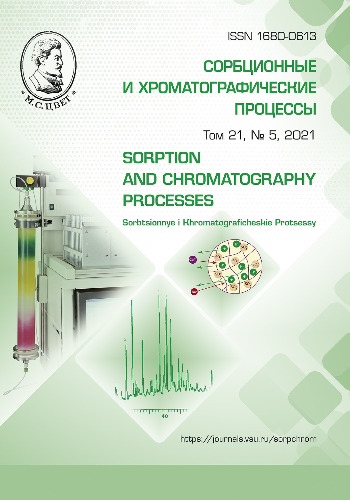Identification of cefazoline and cefatoxime in liquid media using modified piezoelectric sensors
Abstract
The article presents the results of using piezoelectric sensors based on polymers with molecular imprints in order to identify two antibiotics of the cephalosporin series, cefazoline, and cefatoxime, in liquid media. The purpose of our study was to develop piezoelectric sensors based on polymers with molecular imprints of cefazoline and cefatoxime antibiotics for their identification in liquid media.
To identify the antibiotics, piezoelectric quartz resonators were modified with polymers with molecular imprints. Molecular imprinted polymers (MIP) were synthesised based on copolymer of 1,2,4,5- benzenetetracarboxylic acid and 4,4′-diaminodiphenyl oxide produced by OAO MIPP NPO Plastic, Moscow. To obtain the MIPs, we prepared a prepolymerisation mixture containing a copolymer and a solution of the antibiotic in distilled water and N,N-dimethylformamide (DMF) with the ratio of 1:2. The prepolymerisation mixture was applied on the surface of the electrode of the sensor by stamping. Thermal imidisation was carried out in an oven in two stages: the first stage was performed at 80оС, the second at 180°С. The sensors were then cooled to room temperature and placed in distilled water for 24 hours for the removal of the template.
The identification of antibiotics in liquid media was performed using the method of graduation graphs. To plot the graph, standard antibiotic solutions were prepared within the range of concentrations of 0.1 – 1.0·10–7 g/dm3. When the concentration of the analyte in the solution increases, the analytical signal of the modified piezoelectric sensor decreases. At the same time, we observe a linear calibration dependence with the coefficient of determination being R2>0.99.
The identification limit is 1.0·10-6 g/dm3 for cefazoline and 1.0·10-5 g/dm3 for cefatoxime. The range of the determined concentrations of the antibiotics is 0.1-1.0·10-6 g/dm3 and 0.1-1.0·10-5 g/dm3 respectively. The imprinting factor is 61.6 for the cefazoline MIP and 10.0 for the cefatoxime MIP. For cefazoline MIP, the selectivity coefficient was calculated with regard to cefatoxime and was 0.052. It was 0.39 for cefatoxime MIP (calculated with regard to cefazoline). The sensors are only selective for target template molecules. The study demonstrated that the milk matrix does not affect the analytical signal. Sensors in binary antibiotic solutions demonstrate selectivity for the antibiotic that served as a template for the MIP synthesis. Piezoelectric sensors based on molecular imprinted polymers of cefazoline and cefatoxime are highly specific for the identification of template molecules in individual and multicomponent mixtures.
Downloads
References
Kharkevich D.A. Farmakologiya. M. GE`OTAR-Media. 2006. 750 p.
Yakovlev V.P., Yakovlev S.V. Raczional`naya antimikrobnaya farmakoterapiya. M. Lit-terra. 2007. 784 p.
Kulapina E.G., Barinova O.V., Kulapina O.I., Utcz I.A. et al., Antibiotiki i khimioterapiya, 2009, Vol. 54, No 9-10, pp. 53-60.
Buzmakova U.A., Kudryashova O.S., Vestnik Permskogo universiteta. Khimiya, 2018, Vol. 8, Is. 1, pp. 6-28.
Papunidi E`.K., Vy`shtakalyuk A.B., Aktual`ny`e voprosy` sovershenstvovaniya tekh-nologii proizvodstva i pererabotki produkczii sel`skogo khozyajstva, 2020, No 22, pp. 426-429.
Minaeva L.P., Sheveleva S.A., Uspekhi mediczinskoj mikologii, 2019, Vol. 20, pp. 441-444.
Murlenkov N.V., Biologiya v sel`skom khozyajstve, 2019, No 4 (25), pp. 11-14.
Kurchenkova O.R., Shmat E.V., Vestnik nauchny`kh konferenczij, 2017, No 3-5 (19), Ch. 5, pp. 112-113.
Gerajmovich O.A., Malinina Z.Yu., Molochnaya promy`shlennost`, 2009, No 9, pp. 44-45.
Hancu G., Simon B., Kelemen H., Rusu A. et al., Advanced Pharmaceutical Bulletin, 2013, No 3(2), pp. 367-371.
GOST 33526-2015. 14 p.
GOST 34137-2017. 24 p.
Shazalia M.A., Elbashir A.A., Aboul-Enein H.Y., World Journal of Analytical Chemistry, 2015, Vol. 3, No 1 A, pp. 21-32.
GOST 31502-2012. 14 p.
GOST 32219-2013. 20 p.
GOST 32254-2013. 13 p.
Zyablov A.N., Nikitskaya L.M., Zhibrova Yu.A., Kalach A.V. et al., Patent RF. No 2010142819/28. 2010.
Zyablov A.N., Monicheva T.S., Sel-emenev V.F., Analitika i kontrol`, 2012, Vol. 16, No 4, pp. 406-409.
Zyablov A.N., Govorukhin S.I., Duvanova O.V., Selemenev V.F. et al., Analitika i kontrol`, 2014, Vol. 18, No 4, pp. 438-441.
Ny`s P.S., Kurochkina V.B., Sklyarenko A.V., Vejnberg G.A., Antibiotiki i khimioterapiya, 2000, Vol. 45, No 11, pp. 36-42.
Egorov N.S., Osnovy` ucheniya ob antibiotikakh, M., Izd-vo MGU, Nauka, 2004, 528 p.
Glushhenko N.N., Pletneva T.V., Popkov V.A., Farmaczevticheskaya khimiya, M., Izdatel`skij czentr «Akademiya», 2004, 384 p.
Sokolova L.I., Chernyaev A.P., Khimiko-farmaczevticheskij zhurnal, 2002, Vol. 36, No 5, pp. 39-45.
Khal`zova S.A., Dis. kand. khim. nauk., Voronezh, 2017, 129 p.
Bessonov M.I., Koton M.M., Kudryavczev V.V., Lajus L.A., Poliimidy` – klass termostojkikh polimerov, Leningrad, Nauka, 1983, 328 p.
Merenkova A.A. Vu Kh.I., Grech-kina M.V., Zyablov A.N., Sorbtsionnye i khromatograficheskie protsessy, 2020, Vol. 20, No 6, pp. 760-764.https://doi.org/10.17308/sorpchrom.2020.20/3144
Derfel` K., Statistika v analiticheskoj khimii, M., Mir, 1994, 268 p.
Dvorkin V.I., Metrologiya i obespechenie kachestva kolichestvennogo khimicheskogo analiza, M., Khimiya, 2001, 263 p.
Dmitrienko S.G., Irkha V.V., Kuz-neczova A.Yu., Zolotov Yu.A., Zhurnal analiticheskoj khimii, 2004, Vol. 59, No 9, pp. 902-913.
Amelin V.G., Andoralov A.M., Volkova N.M., Korotkov A.I. et al., Analiti-ka i control, 2015, Vol. 19, No 2, pp. 189-207.







